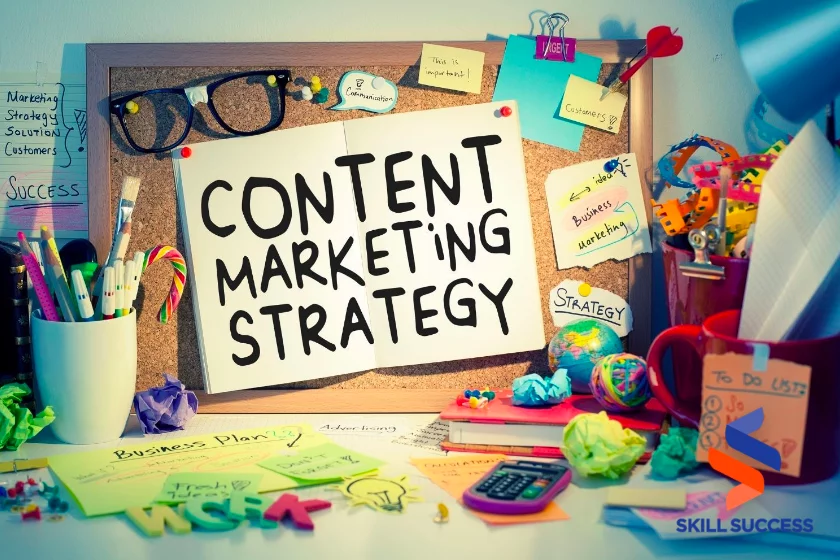You’re immediately greeted by a deluge of content when you browse online. From compelling blog posts and landing pages to eye-catching images and strategically placed popups, brands meticulously craft each piece of content to bolster their digital footprint and catch people’s attention.
But constantly creating and optimizing fresh content demands considerable effort, talent, and resources. Enter AI technology. With its capabilities, content teams can supercharge their content strategy. Are you intrigued to learn more about how you can use AI content strategy for your brand? Here’s everything you need to know.

What is AI content marketing?
As the name suggests, AI content marketing refers to applying AI technology in the marketing realm—specifically, to craft and optimize content.
AI content strategy leverages tools to gain unique insights into your audience’s demographics, behaviors, and interests to create and personalize content that resonates deeply with your target audience and addresses their needs and preferences.
For instance, content creators can whip up AI-generated images designed to engage users based on their preferences and behaviors. This strategic approach enhances audience engagement and drives them to act, whether signing up, clicking on a link, or purchasing a product.
How to Use AI in Content Strategy
AI draws upon learned patterns and data processing to emulate human cognitive processes and behaviors and execute many tasks. Below are different examples of how you can use AI in content marketing.
1. Create Unique, Engaging Content
A successful content strategy hinges on delivering engaging content that resonates with your audience. But let’s face it: researching topics, drafting outlines, and fleshing out comprehensive content can be daunting. While AI can’t replace human creativity, it can undoubtedly enhance your content workflow, alleviate writer’s block, and ignite the spark you need to kickstart your writing.
Using the best AI writer can significantly support your AI content strategy by analyzing your competitor’s content, generating ideas, and supplying original, error-free content that matches your brand’s tone and style.
2. Optimize Existing Content
AI doesn’t only come in handy with whipping up new content. It could also be a game-changer when it comes to optimizing existing ones. AI-powered tools can help evaluate the performance of your existing content, identify gaps, and provide actionable recommendations— from keyword tweaks to meta description adjustments, all to elevate your SERP ranking.
3. Design Powerful Presentations
Creating a presentation is a powerful way to prove the value of your products or services to your potential customers. But making these can be demanding; while you may have the content figured out, nailing the designs and transitions requires a blend of creativity and skill.
You can utilize an AI presentation maker as part of your AI content strategy to generate customized, visually striking presentations based on the prompts you provide, significantly easing your workload.
AI can also sift through large datasets and extract patterns and trends to create actionable insights. But why stop there? Harness AI further to transform these insights into visually compelling charts and graphs, ensuring your findings don’t just get seen but genuinely resonate.

4. Optimize Email Marketing Campaigns
Deploying email marketing can help you generate leads, nurture your existing customers, and guide them through the buyer’s journey.
To optimize your email marketing campaigns, consider integrating AI email marketing tools into your AI content strategy. These tools can curate content for your subscribers based on their past clicks, purchases, and page views. They can also intelligently schedule your emails to coincide with your subscribers’ peak activity times, boosting open rates and overall engagement.
5. Produce Stunning Visuals
While text is crucial for content—given it’s what Google indexes—incorporating visuals is equally vital. After all, humans are inherently visual creatures. Engaging visuals make your brand more memorable and clarify your message and motivate your audience to interact with you.
Securing a talented graphic artist often comes with a hefty price tag. Meanwhile, finding free (or even paid) graphics that align with your needs, brand voice, and style can be difficult.
Luckily, you can incorporate AI programs that generate images in your AI content strategy. Doing so eliminates the need to comb the internet for the perfect royalty-free visuals.
6. Streamline Your Social Media Strategy
Crafting content and responses for your social media is only half the equation. Fortunately, AI content strategy doesn’t stop with creating content for your brand’s social media content; AI-powered tools can also help with your social media campaigns, from crafting persuasive ads to identifying influencers aligned with your audience.
Is AI content good for SEO?
The big question is: will adopting an AI content strategy mess up your SEO? Remember, search engines mostly don’t sweat how your content got made. If it’s valuable, on-point, and answers people’s burning questions, boosting your brand’s content with AI content strategy might snag a top spot in the search results.
While AI tools are smart, they aren’t perfect. While using AI in content marketing can significantly aid your overall content strategy, it’s crucial to have a human expertly give your content a good once-over.
Approaching AI content strategy carelessly can result in penalties and, more importantly, a loss of your audience’s trust. After all, it’s not just about climbing the rankings—it’s about truly engaging your audience.

Conclusion
Harnessing the power of AI content strategy can greatly build your brand awareness, automate tedious tasks, and personalize your outreach like never before. Think about it—from spicing up your email campaigns and whipping up standout content to creating eye-popping visuals and presentations, AI is totally shaking up how we do content marketing.
Yet despite these advances in AI technology, human oversight remains crucial to ensure the accuracy and authenticity of your content. Finding that sweet spot between human touch and AI prowess is key. It’s all about blending tech’s efficiency with genuine human connection, guiding your brand to resonate more deeply with its audience.


